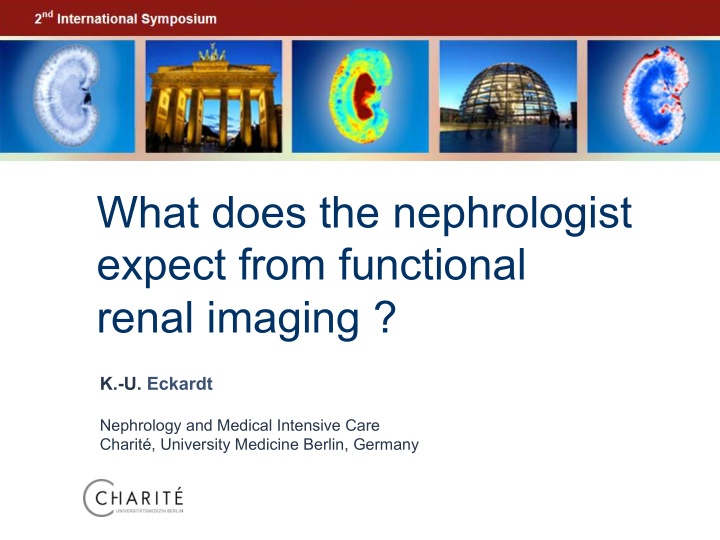



What does the nephrologist expect from functional renal imaging ? K.-U. Eckardt Nephrology and Medical Intensive Care Charité, University Medicine Berlin, Germany
Expectations from renal imaging Better patient care through improved assessment of - Kidney disease risk - Early diagnosis of kidney disease - Differential diagnosis of kidney disease - Underlying pathomechanisms - Therapeutic responsiveness My hypothesis: In nephrology we are underutilizing the opportunities of modern imaging.
Expectations from renal imaging Better patient care through improved assessment of - Kidney disease risk - Early diagnosis of kidney disease - Differential diagnosis of kidney disease - Structure / function correlations - Underlying pathomechanisms - Risk for kidney disease progression - Therapeutic responsiveness My hypothesis: In nephrology we are underutilizing the opportunities of modern imaging.
Expectations from renal imaging Better patient care through improved assessment of - Kidney disease risk - Early diagnosis of kidney disease - Differential diagnosis of kidney disease - Structure / function correlations - Underlying pathomechanisms - Risk for kidney disease progression - Therapeutic responsiveness My hypothesis: In nephrology we are underutilizing the opportunities of modern imaging.
Ways forward … . Standardized imaging protocol that allows qualitative and quantitative, objective assessment and analysis of structural (and functional) parameters To be correlated with … .. • Clinical parameters (cross sectional) • Course of disease (retro- and prospective) • Other imaging parameters (ultrasound, CT) • Histology on biopsy specimens • Other parameters in specific settings (e.g. after nephrectomy)
German Chronic Kidney Disease Study 5000 Patients - CKD stage 3 (eGFR 30-60) or overt albuminuria - under care of nephrologists Kidney failure • Diabetes mellitus (dialysis) progressive • Hypertension ? loss of function • Glomerulonephritis ? Other ? • Polycystic Kidney CKD c outcomes a r d i o Disease v a s c d u i s l a e r a s e • Vasculitis ? Cardiovascular • others complications, death Clinical Phenotype Biomaterials Outcome - DNA - Serum, Plasma - Urine prospective follow-up (up to 10 years) Eckardt et al., NDT 2011
Baseline eGFR and Albuminuria Proportions of patients in different categories (%) A1 A2 A3 30-300 mg/ g < 30 mg/g > 300 mg/g G1 > 90 0 1 2 G2 60-89 6 3 4 G3 a 45-59 20 8 6 G3 b 30-44 19 13 8 Based on G4 15-29 3 3 4 Levey et al., Kidney Int 2010 G5 < 15 0 0 0 Risk categories 6 24 33 33 4 Titze et al., NDT 2014
Recruitment and Follow-Up October 2017 2 years Loss to follow-up: N=91 (1.55%) Consent withdrawn: N=2 (0.04%) N= 5217 Left study: N=266 (5.10%) Death: N=568 (10.89%) BL FU 1 FU 4 FU 6 FU 2 FU 3 FU 5 FU 5
Ways forward … . Standardized imaging protocol that allows qualitative and quantitative, objective assessment and analysis of structural (and functional) parameters To be correlated with … .. • Clinical parameters (cross sectional) • Course of disease (retro- and prospective) • Other imaging parameters (ultrasound, CT) • Histology on biopsy specimens • Other parameters in specific settings (e.g. after nephrectomy)
Department of Nephrology & Intensive Care Largest Nephrology Center in Germany Possible seetings in which MRI could be integrated into routine care ( with protocols and ethic approval ): - Patients with AKI / CKD prior to kidney biopsy - Healthy kidney donors prior to nephrectomy - Patients with specific etiologies of CKD
Ways forward … . Standardized imaging protocol that allows qualitative and quantitative, objective assessment and analysis of structural (and functional) parameters To be correlated with … .. • Clinical parameters (cross sectional) • Course of disease (retro- and prospective) • Other imaging parameters (ultrasound, CT) • Histology on biopsy specimens • Other parameters in specific settings (e.g. after nephrectomy)
Recommend
More recommend